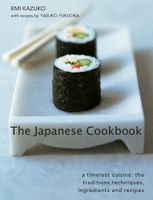Label
All
0
Clear all filters
🔥 Try our grilling cookbooks and save 25% on ckbk membership with code BBQ25 🔥
How sake is made
Appears in
By Emi Kazuko and Yasuko Fukuoka
Published 2024
Sake is made from rice, but the rice used for making it is a harder variety than the rice used for eating. The rice is first intensely refined by shaving off the husk made of fat and protein, reducing the grain to just its core. How far it is refined (50, 60 or 70 per cent) determines the quality of the end product. The rice is then soaked in water and steamed at a high temperature. After cooling, it is transferred to a vat and left to turn into koji (rice malt) over a 48-hour period.
More steamed rice, a yeast like agent and water are added and stirred to make a mash, to which steamed rice, koji and water are again added. The mash is finally left in a tank to ferment. It will attain an alcohol content of 18 per cent in about 20 days and the fermented mash is squeezed to exude the liquid. The liquid is then pasteurized at 60°C/140 °F and transferred to a brewing tank to mature. Sake-making starts in autumn and the wine is ready in 60 days. To best appreciate it, drink within a year of bottling.
Become a Premium Member to access this page
Unlimited, ad-free access to hundreds of the world’s best cookbooks
Over 160,000 recipes with thousands more added every month
Recommended by leading chefs and food writers
Powerful search filters to match your tastes
Create collections and add reviews or private notes to any recipe
Swipe to browse each cookbook from cover-to-cover
Manage your subscription via the My Membership page
Best value
Part of
Advertisement
Related Recipes
-
-
-
-
Related Reference
-
-
-
-
Advertisement
The licensor does not allow printing of this title




